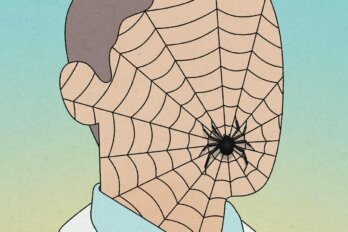“Sneezes for All. That Fashionable Influenza Will Surely Cross the Sea.” On December 13, 1889, this headline—half jest, half warning—was tucked into the top left-hand corner of page seven of the New York Sun.
“Europe has an epidemic of influenza,” the (New York) Evening World blared, “but do not be frightened. All agree that this latest fad is not dangerous to life—only annoyingly disagreeable to him who has it and excruciatingly funny to him who has it not.” And so, in the waning days of 1889, tucked between news articles about twenty-cent Christmas trees and the execution of a Japanese man for a rooming-house murder, the first hints of a pandemic were reported to a US public in terms at once reassuring and dismissive. “The first symptom is a sneeze,” the article continued. “Then the nostrils will feel dry. There will be a tightness of the chest. You will cough a dry cough and your throat will be sore. Then you will wonder if life is really worth the bother of living, your spirits will go down, your ambition ooze out at the ends of your fingers and a languor will possess you. You will not care whether school keeps or not for about ten days, then you will brace up, and in another week you will be able to laugh at your neighbor, who is just beginning to sneeze his head off.”
The winking irony of the reporting would, in a matter of weeks, abruptly end. Fifteen days after the Evening World’s report, on December 28, 1889, Thomas Smith, a twenty-five-year-old from Canton, Massachusetts, became the United States’ first recorded “Russian flu” fatality. New York was particularly hard hit as Americans received glimpses of the full horror of the pandemic racing across the globe. “Nearly 600 Fatal Cases Reported in Paris in One Day,” read a headline in the New York Sun. “The influenza is spreading and is very fatal,” the article stated, accompanied by dispatches from Paris (“Fully one-third of the populace is prostrate”), Vienna (“The hospitals in this city are crowded with patients suffering from influenza”), Lisbon (“Two thousand have the influenza, including the Queen”), and cities across America. In New York, a famed acrobat in a hit play caught “La Grippe”; his manager received a certificate from his doctor stating that he “would probably not live through the night.” In Boston, 25,000 people were reported sick with the Russian flu, and authorities said that as much as 10 percent of the city’s population had been infected. Ultimately, more than 1,200 New Yorkers and 15,000 people across the United States died in the first few months of 1890. The dead numbered over 1 million around the world.
It has long been assumed that the Russian flu was just that: an illness caused by an influenza virus. This was a relatively clear-eyed assumption to make. After all, in the absence of any other major respiratory viruses, influenza was the only suspect. There was also the matter of timing. The Russian flu followed on the heels of successive influenza pandemics in 1729, 1781, and 1830, all of which had emerged at roughly fifty-year intervals, a fact that made it rather predictable that a new influenza would strike in the waning decades of the nineteenth century. (Without microscopes powerful enough to see the structures of viruses—the electron microscope was invented in 1931—scientists had only a dim sense of the pathogens causing these recurring flare-ups.) This influenza hypothesis was bolstered nearly thirty years later, after the Spanish flu pandemic of 1918, which killed 3 percent of the world’s population. In the aftermath of the Spanish flu, experts pointed to the Russian flu as its likely viral precursor, a harbinger of doom that humanity had failed to heed.
It wasn’t until the SARS epidemic, when a pathogenic human coronavirus was first recorded, that scientists started to question whether the twentieth century’s obsession with the flu might have been misplaced. While it was conceivable that the Russian flu was a precursor to the Spanish flu, the two pandemics produced subtly different symptoms. Perhaps most strikingly, the Russian flu had a peculiar telltale symptom: the loss of smell and taste, which was common among those infected with coronaviruses but not among those with influenza.
In 2005, with SARS fresh in his mind, Belgian virologist Marc Van Ranst decided to dig into the origins of HCoV-OC43, a human coronavirus. While our species has become the natural reservoir for OC43, Van Ranst knew that the virus’s closest relative wasn’t a human coronavirus. Instead, OC43 was nearly indistinguishable from—or 98 percent identical to—bovine coronavirus, which infected only cattle. This meant that OC43 almost certainly emerged from sustained contact between coronavirus-infected cattle and human beings. By charting the 2 percent of genomes that differed between the two closely related viruses and then applying a molecular clock analysis to track how long those changes would have taken to arise, Van Ranst was able to pinpoint the moment when the virus first diverged from its most recent viral ancestor and began to infect our species. He was helped in this effort by Susan Weiss, an American microbiologist who had spent the 1980s and ’90s identifying which sections of coronavirus genomes were prone to mutation and how key changes made the viruses less deadly. When he ran the molecular clock analysis on OC43, Van Ranst landed on 1890 as the year it had separated itself from its closest ancestor, bovine coronavirus. Because molecular clock analysis is more reliable the closer the zoonotic leap is to the present, the time period of uncertainty around OC43’s emergence was also relatively narrow: between 1859 and 1912. That’s when Van Ranst realized that the evidence pointed to a coronavirus pandemic hiding in plain sight.
The Russian flu was not, in fact, one of the influenza pandemics that regularly appeared every fifty years. Instead, Van Ranst proposed that shifts in the epidemic triangle—a model for tracking infection involving a pathogen, a host, and an environment—leading up to 1890 had caused the ideal conditions for a coronavirus to jump from cattle to humans. Beginning in 1850, cattle across the world began to suffer from a disease that caused fever, respiratory tract infections, and dysentery. Because these livestock were transported cheek by jowl, the infection, known as cattle fever, reached pandemic levels. Fevered cattle, driven across wide prairie expanses or shipped for weeks by boat, would drop dead en route; whole herds were felled by the disease. Ultimately, using nineteenth-century technologies, scientists identified the purported agent of disease: Mycoplasma mycoides, a deadly and highly transmissible bacterium that spreads through herds via respiratory droplets. But the case was hardly closed. As far back as 2005, researchers pointed out that the symptoms the bacterium produced were essentially indistinguishable from those of bovine coronavirus infection. And, while M. mycoides can’t infect humans, the fact that OC43 and bovine coronavirus were 98 percent identical meant that the newly emergent CoV could likely—and eventually did—jump from cattle to human beings. (From which source bovine coronavirus first emerged is a mystery, though the virus is closely related to rat, pig, horse, and bat strains.) The novel pathogen just needed the right environment to reach its human hosts. Van Ranst and others suspected that the real cause of the Russian flu had been lurking in cattle herds throughout the late nineteenth century, hidden by the more easily detectable M. mycoides bacteria.
Beginning in the 1870s, countries across the world began massive culling operations, some of which lasted decades, to eradicate cattle fever. Millions of herds of cattle were slaughtered to stop the spread, which put humans and infected cows in prolonged and intimate contact. As cattlemen in fields and barns held the animals in place, readying them for their deaths, human and animal breaths commingling as the beasts were dispatched into darkness, both bacteria and virus would have found their way from cow to man—but only one of those pathogens would have been able to flourish in its new hosts. Repeat this scene over two decades and across the world, and the chances of a zoonotic jump move from unlikely to inevitable—but only, of course, if the pathogen had the right tools to survive the journey. OC43, like so many members of its viral family, had those tools. That it succeeded is beyond debate. Billions of copies of the virus circulate freely among us, evidence that it has attained the viral equivalent of immortality: OC43 has become endemic among our species.
SARS pushed researchers to probe the origins of known coronaviruses throughout history. It also launched a search for new members—and new threats—emanating from the viral family. And so, while Van Ranst was decoding the byzantine trail of mutations that led OC43 to separate itself from bovine coronavirus, other researchers were stumbling upon evidence of coronaviruses that had also successfully made zoonotic leaps. The 2004 discovery of HCoV-NL63 by Dutch virologist Lia van der Hoek marked the first time scientists had isolated an endemic human coronavirus since OC43 and 229E (both benign) were discovered in the 1960s. In the wake of SARS, Van der Hoek’s detection of NL63 revealed a stark reality: our species was more deeply entangled with the Coronaviridae than anyone had realized. If the field of coronavirology had been a backwater before SARS, it became something of a curiosity after the epidemic went global. Still, nobody knew how long the family had been evolving to master our host biology and carve out a home within our bodies.
Van der Hoek wanted an answer, so she cross-referenced the genomic makeup of NL63 with its known relatives and discovered that HCoV-229E was its closest known match. Unlike OC43 and bovine coronavirus, though, NL63 and 229E weren’t nearly identical; they were more like distant cousins, sharing only about 65 percent of their total structure. This placed the moment that the two viruses branched off from each other much further back in time. But when? One of Van der Hoek’s graduate students, Krzysztof Pyrc, set about trying to find an answer. By charting the differences in the genomes of NL63 and 229E and then watching the speed of each virus’s mutations, Pyrc wound the clock back to a wide historical range, 966 to 1142, and then to a specific year, 1053, when NL63 emerged out of the zoonotic sea to conquer the human species.
China’s Northern Song dynasty was an imperial era that ushered in a period of political stability and harmonious social relations after decades of civil war. During this time, the population of China boomed from roughly 32 million in 960 to more than 100 million by the fall of the dynasty, in 1127—almost 30 million more citizens than the Roman Empire at its peak. Kaifeng, the capital, flourished, its million-plus residents densely packed together in close quarters. As the Chinese political state stabilized, land and sea routes kept expanding, reaching farther and farther away and bringing contact with new places, new people, and undoubtedly, new pathogens. In short, it was the perfect environment for an emergent virus to exploit.
Over a span of nearly two decades, from 1041 to 1060, ten major epidemics hit China, an unprecedented conflagration of disease. But that was just the beginning. The spike in epidemics would continue over the next eighty-five years, until the demise of the Northern Song dynasty, with twenty-eight major epidemics mentioned in official court records. In the years when NL63 is estimated to have emerged, one philosopher-physician classified the illnesses of the epidemics as “cold damage disorders.”
Xu Shuwei, a Northern Song physician, compiled case studies of such disorders. His reports of cold damage disorders caused by epidemic diseases—which he described as arising from “warm winds”—are tantalizingly similar to the set of symptoms caused by human coronaviruses. It was a warm wind that Xu pinpointed as the cause of an epidemic he saw spread after a border conflict with one of China’s many neighbours. “When warm wind causes a disorder, there is spontaneous perspiration, the body feels heavy, the patient sleeps a lot, his breathing through the nose makes snoring sounds, and it is also difficult for him to speak.” Update the language, and Xu could have written the US Centers for Disease Control’s Symptoms of Coronavirus list.
We cannot say for certain that NL63 was the pathogen that drove decades of epidemics across China. We can, though, rule some others out. The Black Death, which killed as many as 200 million people, emerged as a pandemic only in the middle of the fourteenth century, roughly two centuries after the Song dynasty. And, though influenza viruses, which cause many of the same symptoms as human coronaviruses, are believed to have been present in China for at least many thousands of years, the first recorded flu pandemic didn’t occur until 1580.
So, while the escalating epidemics ultimately outlasted the Song dynasty and can’t be definitively linked to NL63, they may nevertheless mark one of humanity’s first protracted battles with the Coronaviridae.
There is a version of modern human history in which the pandemic potential of coronaviruses was recognized early. If it had been, the careful work of coaxing life-saving information out of these bloated, balloon-like virions could have begun with the nineteenth-century Russian flu rather than at the dawn of the twenty-first century, during the SARS epidemic. In that other version of history, humanity would as a matter of course have undertaken early and concerted efforts to develop coronavirus vaccines, just as we have for influenzas. Coronaviruses, widely considered curiosities, concealed dark pasts as terrifying human pathogens.
The sad truth is that innovation in epidemiology, the science of epidemics, is a frustrating kind of progress, always facing backward. The epidemiologist’s job is to discover the origins of epidemics in order to control them. The harder task is preventing those that have not yet emerged. Each time a novel pathogen creates a foothold in human hosts, we’re reminded of just how poor our species is at anticipating the viral threats we will inevitably face. The sources of flu contagion have long been obvious. Birds and pigs, familiar animals with which our species coevolved, have since the nineteenth century been known as byways for influenza strains to mix, recombine, and find their ways into human beings.
But the animal sources of the Coronaviridae have proven elusive. Genomic sequencing, DNA manipulation, vaccine development—for all the cutting-edge scientific tools at our disposal, we have had a glaring inability to fully grasp the dangers emanating from this strange and bulbous family and to determine its animal origins. Part of this inability has been due to timing: the Spanish flu, that cataclysmic event, occurred just as our knowledge of viruses and our technology had matured to the point that viruses could be seen. Though it took until the 1930s, the Spanish flu was eventually ID’d correctly (as were two other influenza pandemics, in 1957 and 1968) under microscopes. The absence of pathogenic coronaviruses during this stretch meant that humanity fixed its gaze squarely on the danger it could see: the flu.
Still, our failure to match the threat posed by coronaviruses was part of a broader pattern. For all the scientific successes of the twentieth century, this period was actually marked by a steep and quantifiable decline in the rate of scientific production. By the 1930s, the prevailing assumption was that each new invention would speed the next in a kind of “geometric progression.” But, throughout the nineteenth and twentieth centuries, the biggest rise in patents per capita in the United States actually took place before 1870, at a time when most of the nation’s population was still living in the countryside. In the subsequent century, the US population boom obscured the fact that creating inventions was getting demonstrably harder. While the number of scientific workers in the United States tripled between 1950 and 1993, the country’s rate of scientific production remained stable, meaning that it took more people and bigger teams to produce the same number of discoveries as before. On average, research productivity has dropped 5 percent every year since the 1930s.
Nowhere was this drag on innovation more evident than in the pharmaceutical industry. By the 1950s, morphine, penicillin, Aspirin, insulin, and chemotherapy, along with vaccines for polio, measles, smallpox, and tuberculosis, had been developed by or in partnership with private pharmaceutical companies. But the sheer glut of life-saving medicines they produced in the first half of the twentieth century left them with a choice: either take a chance on more difficult goals, like vaccines for rare or emerging diseases—and risk costly failures—or use their library of intellectual property to make incremental improvements to existing products that were surefire money-makers. By and large, they chose the safer route. This trend continued well past the turn of the twenty-first century. For all humanity’s awe-inspiring discoveries, our capacity to meet new viral threats has largely calcified in the face of ruthless market forces.
By 2003, when SARS emerged, the creation of drug therapies and vaccines for novel pathogens had slowed to barely a trickle. And so, when, after more than a century of lying dormant, the Coronaviridae family once again threatened our species, it found us made vulnerable by hubris, rigidly fixed on the dangers of the past, and unable to muster our forces to contend with what might lie ahead. The future, it seemed, had been ceded to our enemies.
Excerpted from The Invisible Siege: The Rise of Coronaviruses and the Search for a Cure by Dan Werb. Copyright ©2022 Daniel Werb. Published by Crown, a division of Penguin Random House Limited. Reproduced by arrangement with the publisher. All rights reserved.




